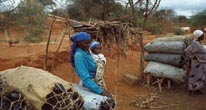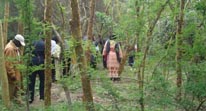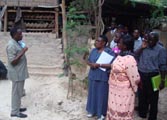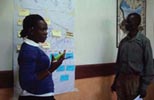| Case: Kenya Afforestation for Charcoal | |||||
| |||||
Kenya Afforestation Charcoal – A Community Driven Commercial Afforestation
Reviewed by Timothy Byakola, CDI / INFORSE East Africa, Uganda.
Background and Context
Although potentially renewable, forest resources in Kenya are exploited at
a higher rate than their supply is renewed, rendering them non-sustainable
in practice.
As a result of this exploitation, Kenya's forest resources cover only around
6% of the country’s 58.2 million hectares and are estimated to be decreasing
by 2% annually. Forest cover is very low compared to the United Nations’ globally
recommended 10% for ecological stability of the country. In 2002, wood fuel
demand and supply in Kenya was estimated to be 32 million tonnes and 16 million
tonnes respectively. This is a 50% deficit, drawn from standing wood stocks,
leading to deforestation, and environmental degradation. Besides the suffering
of women and children who bear the burden of providing household fuel, increased
deforestation reduces the forests’ carbon sink capacity, contributing
to changes in climate and rainfall patterns that interfere with food production
and security.
Increased water runoff contributes to greater soil erosion and downstream floods. Firewood is mainly a rural fuel with over 90% of Kenya’s rural population dependent on it. Charcoal made from wood, on the other hand, is produced by rural people as a source of income. Charcoal is mainly an urban fuel, with 82% of the urban population using it. Increasing urbanization of the population (7.4%) and the subsequent increase in charcoal consumption has lead to an increase in deforestation. In the 1980s and early 1990s charcoal was mainly obtained from natural woodlands. However, over time, natural forestry resources have declined drastically necessitating deliberate intervention to increase resource supply. Worse still, over 99% of the charcoal produced in the country is processed in traditional earth kilns with a 10% conversion efficiency, so for every 100 kilogram of wood, only 10 kilograms of charcoal is obtained, despite there being technologies with 30% efficiency that can yield three times more charcoal for the same wood.
Determined to make a difference in this region, the Youth to Youth Action Group, with financial support from Thuiya Enterprises Ltd., initiated the community-driven commercial afforestation project in 2002 on 200 hectares of land, in Madiany Division, to enhance the livelihoods of the local communities. The project promotes the growing of Acacia xhanthophloea and Acaciapolyacantha for charcoal. Acacia xhanthophloea,commonly referred to as Naivasha thorn or fever tree (Alii in Luo), is a fast growing acacia species that grows at a rate of 1.0 metre to 1.5 metres per year, thriving at altitudes of 600-2100 metres above sea level, and ideally suited to near swamps, along rivers or lakesides.
This project has demonstrated that it is possible to produce and market charcoal sustainably.
Different
players
Supporting Services are provided by the Rachar Agroforestry
Initiative for Development (RAID), a farmer umbrella Community Based Organisation.
The Embassy of Finland and the Christian Agricultural and Related Professionals
Association (CARPA) provide technical backstopping, some funding, and resource
mobilization for groups. Moi University and the Kenya Forestry Research
Institute (KEFRI) provide leadership in research. The Ministries of Forests and Wildlife
were involved through the Kenya Forest Service. The Ministry of Energy was
involved in choosing the charcoal processing technology. Transporters provide
support services and form part of the market as intermediary traders.
Benefits
Revenues come to farmers from short seasonal crops for the first and second year. In the third to sixth year, they get income from honey, poultry and dairy goats. In the third year, farmers are loaned one beehive for every 500 Acacia trees planted, with an anticipated yield within three months, providing interim income. The farmer repays RAID for the beehive with 2 kg (US $ 6) of honey from every harvest (US $ 24 per year) for three years. Dairy goats and poultry will be introduced in 2009. The money paid to RAID is used as a revolving fund for buying more beehives. The youth benefit from raising tree seedlings, women from trading in efficient cooking devices, beans and groundnuts, men are mainly involved in tree planting, management and charcoal processing. Women get firewood from tree tops and smaller branches.
Financial capital
from the 200 hectares will provide key actors in the chain with an income
from charcoal of US$1,028,571 after six years. Firewood savings
through energy efficient stoves will save US$20,640p.a., fast-growing crops
US$385,600p.a., transport services US$94,200p.a., wholesaling of charcoal US$214,500
and retailing of charcoal US$321,400. Honey will generate US$ 5,400 per year
for the 60 hives. The number of hives is expected to rise
to 1000 hives earning US$ 90,000 per year. The coordinating CBO, RAID, gets
an income of US$160 from the donor for raising seedlings for every hectare
of trees planted. To date it has earned US$ 32,000 from tree seedlings. The
total financial benefits for all the key actors are about US$ 2,096,911 (charcoal
included) in the six-year rotation period.
Financing
the project
US $ 15,000 in 2007 and US $ 22,000 in 2008 (this increases annually)
Recommendations
This project has potential to improve the livelihoods of the rural poor because
of the high demand for charcoal. The initiative does not require high capital
investments and can be integrated with other enterprises to ensure sustainable
access to food and income benefits. The current initiative has not maximized
its potential because it is still in its pilot phase and the enabling business
environment is not well developed. When fully operational, and the appropriate
enabling environment in place, this initiative can maximize its potential in
supporting rural livelihoods especially if contractual business arrangements
are adopted. This will assure producers of a regular and predictable income
and also assure contractors of a steady supply of the product.
Despite the presence of the large market, if those farmers who produce charcoal
find the business environment is not conducive for them to sell profitably,
and are stressed by the current corruption and harassment from the regulators,
it is easy for the initiative to collapse. However, if the enabling environment
improves, and sufficient investment is provided to reach a threshold level
where the initiative expands naturally, then the project will be very successful.
Since it is a business enterprise, whose every activity is valued, sustainability
is assured provided a market exists.
More info:
Publication: “Bioenergy Market System Development Comparing Participatory
Approaches
in Kenya and Sri Lanka”, January 2011. 20 pages, Prepared for Pisces by
Practical Action Consulting East Africa. Pdf file: www.pisces.or.ke
Final Woprkshop
report “Promoting
Sustainable Charcoal Production and Marketing in Kenya: A Comparative Analysis
through Participatory Market Mapping”
35 pages, March 2010.
Prepared for PISCES (Project 2007-2012) by Practical Action Consulting Eastern
Africa
Pdf file: www.acts.or.ke
INFORSE’s Manual’s Charcoal Section: “Sustainable Energy
Solutions to Reduce Poverty in South Asia” http://www.inforse.org/asia/M_III_briquett.htm
 |
|
| Energy Access | |
| Contents Solutions to provide energy access for all Cases: |
|
| AFRICA | |
| · Kenya: Decentralizing Power Policy | |
| · Kenya: Afforestation for Charcoal | |
| · Mali: Jatropha Biofuel for Rural Electrification | |
| · Mali: Solar Lighting Kits for Rural Areas | |
| · Uganda: Feed-in Tariff for Renewable Energy | |
| ASIA | |
| · India: Solar Dryer | |
| · India: Solar Lantern Charging Station | |
| · India: Household Biogas Plant | |
| · India: Micro-Agroecological Village Development Model | |
| · Nepal: Improved Water Mills | |
| · Nepal: Charging Centre for Solar Lamps | |
| · Sri Lanka: Commercialization of Improved Cookstoves | |
| · Sri Lanka: Standard Code for Domestic Biogas Systems | |
 |
|
The
cases were collected in the framework of the "Southern Voices on Climate
Change" Project. Link: www.climatecapacity.org INFORSE-Asia and INFORSE-Africa |
|



